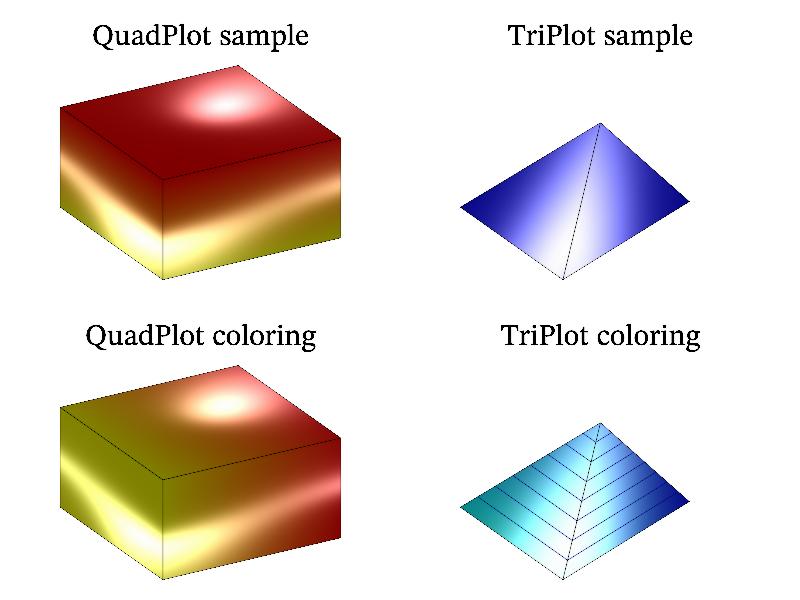11.144 Sample ‘triplot’ ¶
Functions triplot and quadplot draw set of triangles (or quadrangles, correspondingly) for irregular data arrays. Note, that you have to provide not only vertexes, but also the indexes of triangles or quadrangles. I.e. perform triangulation by some other library. See also triangulate.
MGL code:
list q 0 1 2 3 | 4 5 6 7 | 0 2 4 6 | 1 3 5 7 | 0 4 1 5 | 2 6 3 7 list xq -1 1 -1 1 -1 1 -1 1 list yq -1 -1 1 1 -1 -1 1 1 list zq -1 -1 -1 -1 1 1 1 1 light on subplot 2 2 0:title 'QuadPlot sample':rotate 50 60 quadplot q xq yq zq 'yr' quadplot q xq yq zq '#k' subplot 2 2 2:title 'QuadPlot coloring':rotate 50 60 quadplot q xq yq zq yq 'yr' quadplot q xq yq zq '#k' list t 0 1 2 | 0 1 3 | 0 2 3 | 1 2 3 list xt -1 1 0 0 list yt -1 -1 1 0 list zt -1 -1 -1 1 subplot 2 2 1:title 'TriPlot sample':rotate 50 60 triplot t xt yt zt 'b' triplot t xt yt zt '#k' subplot 2 2 3:title 'TriPlot coloring':rotate 50 60 triplot t xt yt zt yt 'cb' triplot t xt yt zt '#k' tricont t xt yt zt 'B'
C++ code:
void smgl_triplot(mglGraph *gr)
{
double q[] = {0,1,2,3, 4,5,6,7, 0,2,4,6, 1,3,5,7, 0,4,1,5, 2,6,3,7};
double xc[] = {-1,1,-1,1,-1,1,-1,1}, yc[] = {-1,-1,1,1,-1,-1,1,1}, zc[] = {-1,-1,-1,-1,1,1,1,1};
mglData qq(6,4,q), xx(8,xc), yy(8,yc), zz(8,zc);
gr->Light(true); //gr->Alpha(true);
gr->SubPlot(2,2,0); gr->Title("QuadPlot sample"); gr->Rotate(50,60);
gr->QuadPlot(qq,xx,yy,zz,"yr");
gr->QuadPlot(qq,xx,yy,zz,"k#");
gr->SubPlot(2,2,2); gr->Title("QuadPlot coloring"); gr->Rotate(50,60);
gr->QuadPlot(qq,xx,yy,zz,yy,"yr");
gr->QuadPlot(qq,xx,yy,zz,"k#");
double t[] = {0,1,2, 0,1,3, 0,2,3, 1,2,3};
double xt[] = {-1,1,0,0}, yt[] = {-1,-1,1,0}, zt[] = {-1,-1,-1,1};
mglData tt(4,3,t), uu(4,xt), vv(4,yt), ww(4,zt);
gr->SubPlot(2,2,1); gr->Title("TriPlot sample"); gr->Rotate(50,60);
gr->TriPlot(tt,uu,vv,ww,"b");
gr->TriPlot(tt,uu,vv,ww,"k#");
gr->SubPlot(2,2,3); gr->Title("TriPlot coloring"); gr->Rotate(50,60);
gr->TriPlot(tt,uu,vv,ww,vv,"cb");
gr->TriPlot(tt,uu,vv,ww,"k#");
gr->TriCont(tt,uu,vv,ww,"B");
}
